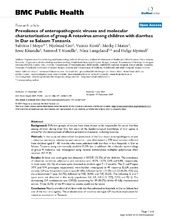Prevalence of enteropathogenic viruses and molecular characterization of group A rotavirus among children with diarrhea in Dar es Salaam Tanzania
Moyo, Sabrina John; Njølstad, Gro; Vainio, Kirsti; Matee, Mecky I.; Kitundu, Jesse; Maselle, Samwel Y.; Langeland, Nina; Myrmel, Helge
Peer reviewed, Journal article
Permanent lenke
https://hdl.handle.net/1956/2678Utgivelsesdato
2007-12-27Metadata
Vis full innførselSamlinger
Originalversjon
https://doi.org/10.1186/1471-2458-7-359Sammendrag
Background Different groups of viruses have been shown to be responsible for acute diarrhea among children during their first few years of life. Epidemiological knowledge of viral agents is critical for the development of effective preventive measures, including vaccines. Methods In this study we determined the prevalence of the four major enteropathogenic viruses – rotavirus, norovirus, adenovirus and astrovirus – was determined in 270 stool samples collected from children aged 0 – 60 months who were admitted with diarrhea in four hospitals in Dar es Salaam, Tanzania, using commercially available ELISA kits. In addition, the molecular epidemiology of group A rotavirus was investigated using reverse transcriptase multiplex polymerase chain reaction (RT-PCR). Results At least one viral agent was detected in 87/270 (32.2%) of the children. The prevalence of rotavirus, norovirus, adenovirus and astrovirus was 18.1%, 13.7%, 2.6% and 0.4%, respectively. In most cases (62.1%) of viruses were detected in children aged 7–12 months. The G and P types (VP7 and VP4 genotypes respectively) were further investigated in 49 rotavirus ELISA positive samples. G9 was the predominant G type (81.6%), followed by G1 (10.2%) and G3 (0.2%). P[8] was the predominant P type (83.7%), followed by P[6] (0.4%) and P[4] (0.2%). The following G and P types were not detected in this study population; G2, G4, G8 G10, P[9], P[10] and P[11]. The dominating G/P combination was G9P[8], accounting for 39 (90.7%) of the 43 fully characterized strains. Three (6.1%) of the 49 rotavirus strains could not be typed. Conclusion Nearly one third of children with diarrhea admitted to hospitals in Dar es Salaam had one of the four viral agents. The predominance of rotavirus serotype G9 may have implication for rotavirus vaccination in Tanzania.
